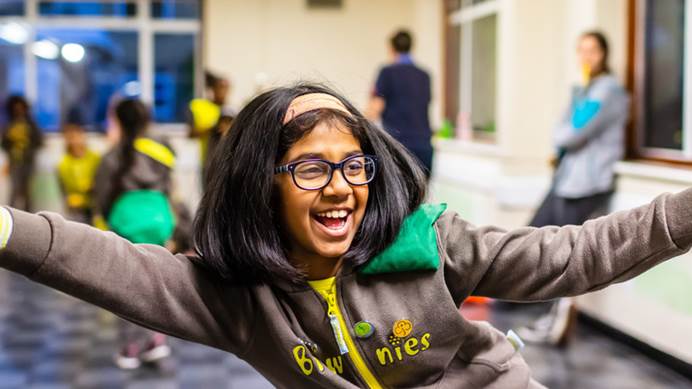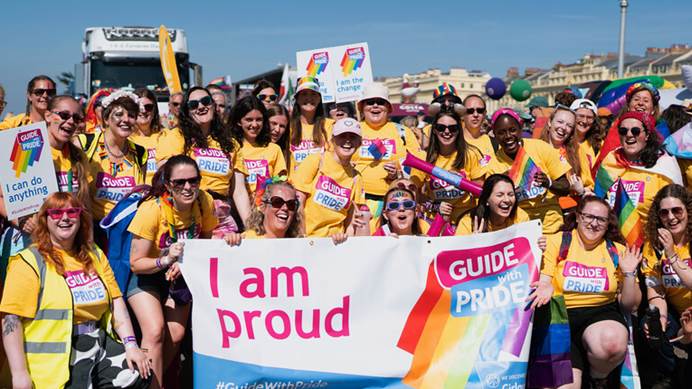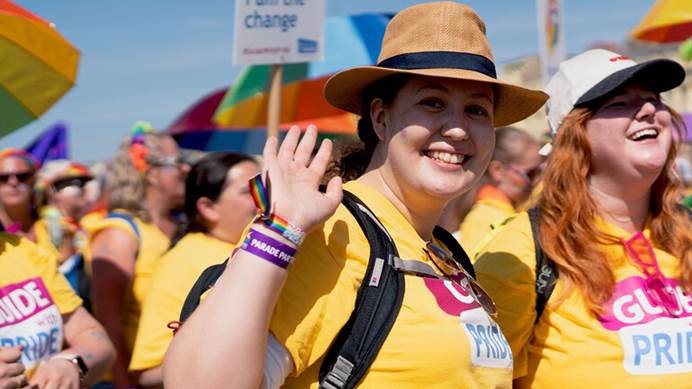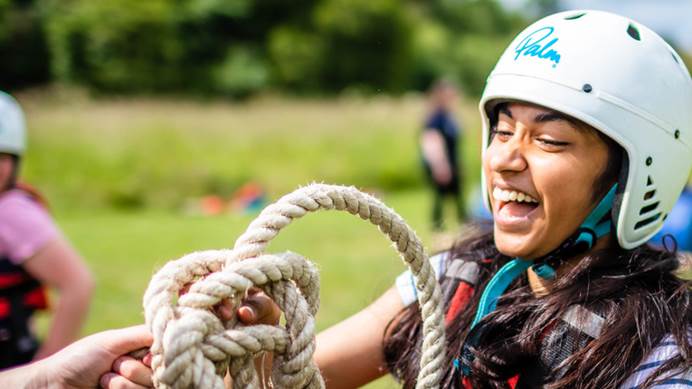Tips to include disabled members and girls
We catch up with Meg Knight and Margaret Duff, our specialist advisors for disability inclusion, to get their advice
We all want Girlguiding to be accessible to all girls and members.
To include disabled members in our activities, we need to remove the barriers they experience. When we remove these barriers, disabled people can be fully included, have independence, choice and control.
We asked Meg Knight and Margaret Duff, our specialist advisors for disability inclusion, for their tips on how parents, carers and volunteers can work together to make adjustments for disabled girls and members.
What tips would you give a parent who has a disabled child joining Girlguiding?
Margaret: ‘Number one - go for it! Guiding is for everyone! Girlguiding exists to help all girls and young women find their voice, and build skills and confidence. We inspire them to discover the best in themselves and empower them to make a positive difference in their community.
‘Number two – Girlguiding is run by volunteers who, although they do receive extensive training and support, may not be an expert in your child’s disability or condition. Please support your local leaders by being open about your child’s needs and by providing as much information and support as you can. If something isn’t working, then let the leaders know early on so things can change and new plans can be put in place.’
What tips would you give a leader who has a new disabled young member/ disabled volunteer joining the unit?
Margaret: ‘Step 1 - Talk to them! Talk to the volunteer, the young member and the young member’s parents/carers. They are the expert in their/their child’s disability. Remember that two people with the same diagnosis may have wildly different experiences and needs. A simple start to a discussion would be “we are planning on doing x,y and z over the next few weeks. How does that sound to you?”
‘Step 2 - Use the adjustment plans! They provide a framework to help you structure the talk you have with individual and, in the case of a child, their parents. Use the form to record the needs that they have identified and the actions that have been agreed to best support them. This means that everyone is on the same page.
‘Step 3 – Share the information, as appropriate, with those that need to know. Make sure that everyone involved knows that you need to share information with the rest of your leadership team and discuss how comfortable they are with this. Sharing information is important in case of emergencies. If the main leader gets caught in traffic and one of the assistant leaders runs the evening, they should know what has been agreed to happen.
‘It may be the case that an individual doesn’t want you to tell others the details of what they’ve shared, but you can still share the agreed actions. For example, you could share with the young leaders in your unit that one of the leadership team is particularly sensitive to loud sudden noises and to try and avoid them, but you don’t have to explain the back story of this trigger.’
Do you have any tips for how to adapt games and activities?
Margaret: ‘Talk to the individual - again, they are the expert! Use open questions such as – what do you play at school or in the playground? What sort of game/craft/sport would you like to do? We are planning on doing x next week, does that sound fun?
‘Remember that you don’t have to stick to the activity cards strictly. You should ensure that you meet the aims written on the front and that you are delivering a high-quality balanced programme, but if the card says “write” you could discuss, draw or act out instead. If the card has a throwing balls activity, you could roll balls instead. If possible, try to adjust the activity for everyone and not just single out one person.’
Meg: ‘It is also important to find out what people are able to do, rather than just focusing on what they might find difficult or are unable to do. As an example, there was a dancing activity during one of our Brownie meetings and one of the girls realised that because of my disability I would be unable to dance. They expressed they felt badly that I wouldn't be able to dance and asked whether they should stop so that I didn't feel left out. I explained that I was able to dance but I did it in a different way. Sometimes it is important to recognise difference when an individual feels comfortable with this.’
Do you have any tips on what language we should use?
Margaret: ‘Language can feel like a tricky subject because there are lots of different views. Some people prefer “person first” language, so a parent may say “my child with autism”. But some people prefer “identity first language”, and might say “my autistic child” instead. There is no right or wrong way, but if you are aware that someone describes themselves using one or the other, try and remember to honour their preference. If you get it wrong, don’t make a big deal out of it, just correct yourself and keep going.
‘Children and young people pick up on the language you use and they listen and understand a lot more than we think they do! Make sure that the language you use is inclusive, and you set a good example. Make sure sensitive discussions are held away from listening ears and never assume that because a child is young or because a person might communicate differently that they can’t understand you.’
What challenges have you faced as a leader when making adjustments?
Margaret: ‘As a leader, it can be frustrating when parents or carers don’t share all the relevant information about their child. Finding out a child has asthma or epilepsy, after having to provide first aid, rush the child to a hospital or ring the parent in a panic can be really scary for both the leadership team and the young people. I hope that as we become more inclusive and welcoming that parents and carers will feel more comfortable sharing information in the knowledge that it will be used to help support the young person, and not to exclude them.’
Meg: ‘I’ve had a few parents, carers, and members say they were concerned about disclosing an impairment, long term health condition or disability. They feared they would immediately be turned away from Girlguiding and that leaders would be unable or unwilling to make reasonable adjustments.
‘As members, it’s important that we focus on removing the barriers that the individual faces. Even if a leader has knowledge or experience of a condition, we have to understand that everyone has a different experience, and that what works for one person may not work for someone else. By showing that we put the individual first, we can reassure parents, carers and members that we want to help.’
Is there anything else you’d like to say?
Meg: ‘As an adult member with a disability, I have personally benefitted from the accessible and inclusive nature of Girlguiding. I’ve seen the impact it has on the young members in my unit who have impairments, long term health conditions and disabilities too. I can’t even begin to tell you how much of a positive impact it has made to my life.
'Girlguiding has given me a purpose, and helped to boost my confidence. It’s provided stability, support, a safe place, and enabled me to better adjust to my life after acquiring my disability and losing my career as a result. Most importantly, it also gave me a sense of belonging when I have otherwise felt excluded and unwanted by society. That’s why I am so passionate about giving others the opportunity to be a part of the organisation and reap these benefits too, because I know and see on a daily basis what it can do.‘



